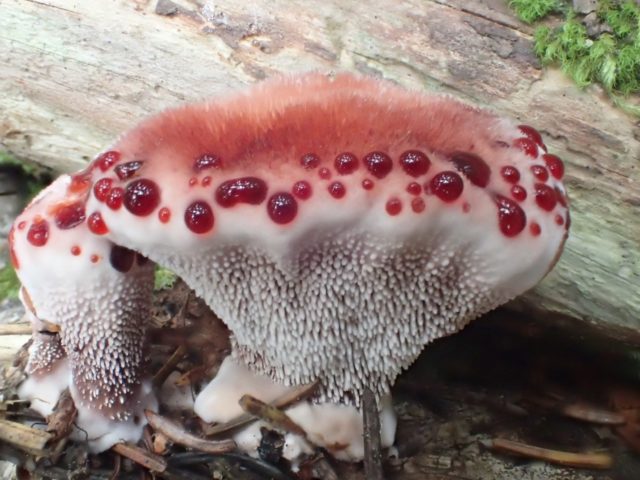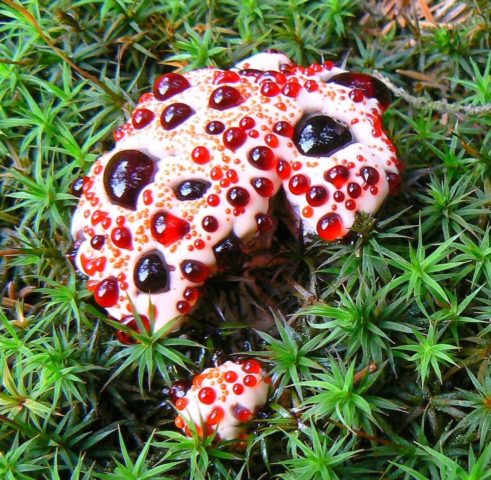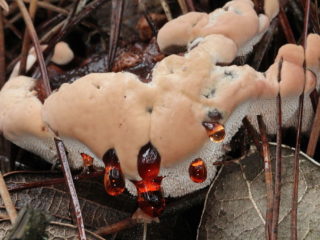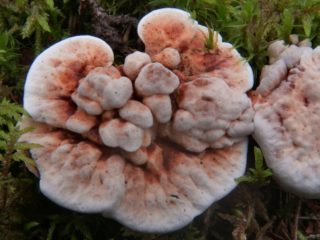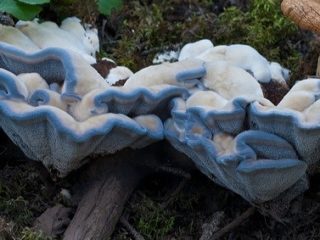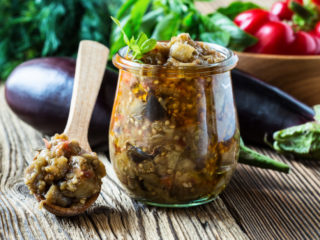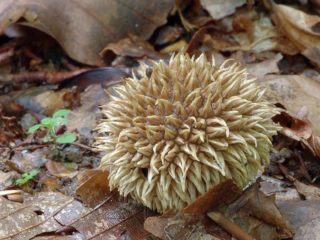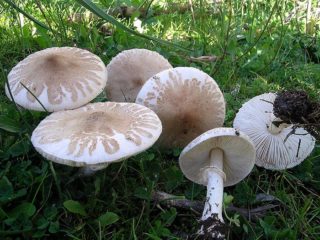Content
A mushroom of the Bankeraceae family, Peck's hydnellum, received its species name in honor of Charles Peck, an American mycologist who described the hydrellum. In addition to the Latin name Hydnellum peckii, under which it is listed in biological reference books, the mushroom is called: bloody tooth, devil's tooth or devil's hedgehog.
What does Peck's hydnellum look like?
The species consists of a cap covering the stem. Hydnellum Peck has no obvious boundary between the upper and lower parts. The fruiting body looks like a funnel, forming immediately from the mycelium. The entire lower part is covered by the hymenium with a jagged structure. The fruiting bodies are located close to each other, often fused laterally, forming a single mushroom.
The external description of Peck's hydnellum is as follows:
- Adult fruiting bodies (sporocarps) can reach up to 11 cm in height, the diameter varies from base to apex, the cap is on average 15 cm, under favorable conditions for growth - 20 cm. The thickness of the stem near the ground is about 3 cm.
- The toothed structure is a specialized part for the production of spores and is the reproductive organ of the species. The spines are very thin, tapering, and cylindrical in shape.
- At the base of the sporocarp, the teeth are long, becoming much shorter towards the edge of the cap, and in some specimens they look like rudiments.
- The arrangement is dense, with five spikes per square meter. mm. At the initial stage of the growing season, they are white with a slight pink tint; after ripening, the spores become dark brown, the color is uniform.
- The surface of the sporocarp is uneven, may be convex or flattened, tuberculate, possibly pressed out in the central part. The shape is round with uneven wavy edges. The structure of mature specimens is fibrous and rigid.
- The mushroom is usually densely covered with fine hair, which gives it a texture similar to felt or velvet. As it grows, the coating peels off and falls off, the caps of mature specimens become smooth.
- At a young age, the color is light beige or white, but over time it darkens, becoming covered with brown or black spots; when pressed, the damaged areas become gray or brown.
- The pulp is pink or light brown, woody, very hard.
- The fruit stalk is short, covered with a needle-like layer, most of it is in the ground, no more than 1 cm protrudes to the surface. At the base it is fleecy, on a tuberous compaction, often covered with moss or small remains of litter mixed with the ground.
The liquid is viscous, sticky, and serves as a distinctive feature of the species and an additional source of nutrition. Hydnellum Peca is the only mushroom that can be classified as a predator. The bright color of the drops and the specific nutty smell attracts insects. They land on the surface of the sporocarp, stick, and become food for the fungus.
Where does Peck's Hydnellum grow?
The fungus is a mycorrhizal species and can only grow in symbiosis with conifers. The hyphae of the Hydnellum tightly entwine the surface root system of the tree, receiving nutrition and giving away elements important for the host’s vegetation. They are found singly or in small groups among fallen pine needles on a moss litter in dry forests. Gidnellum Peka form symbiosis only with perennial trees, so the fungus is not found in young coniferous forests.
The main distribution of Hydnellum Peck is in America and Europe, in mountain or subalpine ecosystems. Slight accumulations of Hydnellum are found in Germany, Italy, and Scotland. In Russia it grows in the Arkhangelsk, Kaliningrad, Irkutsk, and Tyumen regions. Single specimens are found in the forests near St. Petersburg. Fruits in the first ten days of autumn.
Is it possible to eat Peca's Hydnellum?
The fruit body is very hard and fibrous and is not suitable for any processing method. Hydnellum Peca is inedible due to its bitter taste and specific smell, which is reminiscent of fruit and at the same time nutty. The comparison should be in favor of the mushroom, but the smell is so pungent and repulsive with notes of ammonia, it is unlikely to arouse gastronomic interest.As for toxicity, the information is contradictory; in some sources the secreted juice is considered poisonous, in others it is not. In any case, Peck's hydnellum is an inedible mushroom.
Medicinal properties
The chemical composition of the isolated extract contains atromentin, a powerful natural anticoagulant. The substance is stronger in composition than heparin, which thins the blood and prevents the formation of blood clots. This compound is used to treat, for example, thrombophlebitis. Therefore, an extract from Hydnellum could in the future become a good alternative to a pharmaceutical product.
Conclusion
Gidnellum Peck is endowed with an exotic appearance. The liquid protruding through the pores onto the light surface looks like drops of blood. The sinister attractiveness of the mushroom will not leave it unnoticed, but this is only a young specimen. Mature mushrooms are brown and inconspicuous, very tough. The taste is bitter with a pungent odor, the fruit bodies are inedible.

